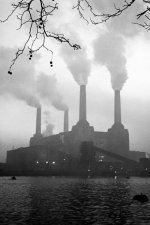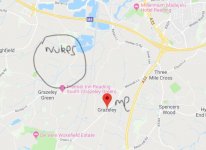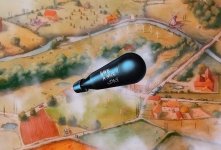Not much (if any) coal mining left in uk
Regulated and publicly brow beat out of business - for "greener alternatives" which, like the US has caused the price of energy to to increase due to artificially created limited supply and need to import. The bottom dropped out of the coal market - so now there is little supply and the what coal is left or imported is MUCH more expensive, adding to the problems, and driving adjacent product prices (natural gas, etc.) prices even higher as well.
There is no end in sight to this. "Alternatives" are not capable of filling the demand, especially at any reasonable price. With each coal fired plant that is shut down, new nuclear or gas fired plant, or well site that is cancelled or held up by environmentalist driven litigation, the price of energy rises.
At the same time, the actors on the planet selfish (or smart) enough to ignore this nonsense and build new coal, gas, nuclear generation capacity, are happily expanding their manufacturing bases - while at the same time devaluing their currency to make the whole shebang even more attractive to those nations wilting under the weight of their own policies.
Load shedding for sure... to the other side of the globe
we found gas in the north sea was a big factor. London smogs were not fun either. power stations in a dip where you get atmospheric inversion is never a good plan, although it did do city heat so would have been fairly efficient. Battersea B only ran for 25 years in the end.
Attachments
Not sure when the B unit was built - but wasn't the original unit from the 30's or 40's?
In any case - yes old dirty low efficiency coal fired station. More modern coal fired stations (and now NG) built and retrofitted from the 70's on produced far more power (500MW - 2+GW) with a much cleaner process.
In any case - yes old dirty low efficiency coal fired station. More modern coal fired stations (and now NG) built and retrofitted from the 70's on produced far more power (500MW - 2+GW) with a much cleaner process.
Last edited:
I grew up in the center of a group of coal fired stations (2-3 650MW units per) 3 within 15 miles, 6 within 50 miles... and maybe 10-12 within 100 miles. Northeast US - were most of the coal came from at the time. All were built in the late 60's early 70's and have been retrofitted several times over the years. Many are Natural gas now.
Funny part is - many were seen as "temporary" that were to last 10 -15 years at best, until more nuclear plants came online.
It was always rumored that the Russians had more warheads pointed at my hometown than anywhere on planet earth - as taking out the mines, and power stations would be more crippling in a first strike than anything else...
Who knows - maybe it was true
Funny part is - many were seen as "temporary" that were to last 10 -15 years at best, until more nuclear plants came online.
It was always rumored that the Russians had more warheads pointed at my hometown than anywhere on planet earth - as taking out the mines, and power stations would be more crippling in a first strike than anything else...
Who knows - maybe it was true
....bets that if the JHA finds out, the property owner has no right to harvest energy from the stream, even if it runs through their property. Imagine that can of worms!...
This can is old. In England from old, and in Connecticut from circa 1800, every inch of drop on every stream was regulated by grants to the site holders. You could not back-up water above your upper limit or demand discharge below your lower limit-- your abutters had their own water rights.
This (and technology) led to the silly solution of installing a steam engine to pump water from your discharge up above your wheel to increase wheel output beyond the limits of natural flow. That's of course a temporary gimmick to preserve sunk costs; as the CT mills got even larger they converted to totally steam. They no longer have water mills lining the streams.
In Maine (who cares) the situation is a little more foggy. When long electric lines were new (1910) one Governor banned export of Maine hydropower; the Legislature killed that policy. But the state does not seem to have much control of where hydro-sites go. The Fed does have extensive power on navigable water, and that has been the crux of several recent squabbles.
Likewise - "high water marks" or variances thereof (ordinary high water mark, etc) that become property of the jurisdiction or public, etc.
Know of a farmer in South Carolina that had a flooded field caused by a debris blocked stream / drainage path (blocked by storm carried debris after hurricane Hugo) that ran past his property. He fought the county for many months to get it cleared. A month turned into a year, etc. Finally, out of frustration, he cleared it and reclaimed his flooded farmland. Can of worms!
His field was, by virtue of the standing water being there for whatever length of time, declared a wetland. It was argued the the "new" HWM was a OHWM and that he in fact damaged a wetland that must be returned to its "natural" state.
Not only did they prevent him from farming the land, and add it to a protected zoning type, but they spent a small fortune building a damn to return the water to the high water mark caused by the blocked stream.
I used to hunt on the property next door and remember the story being a big local deal back then (early 90's).
Know of a farmer in South Carolina that had a flooded field caused by a debris blocked stream / drainage path (blocked by storm carried debris after hurricane Hugo) that ran past his property. He fought the county for many months to get it cleared. A month turned into a year, etc. Finally, out of frustration, he cleared it and reclaimed his flooded farmland. Can of worms!
His field was, by virtue of the standing water being there for whatever length of time, declared a wetland. It was argued the the "new" HWM was a OHWM and that he in fact damaged a wetland that must be returned to its "natural" state.
Not only did they prevent him from farming the land, and add it to a protected zoning type, but they spent a small fortune building a damn to return the water to the high water mark caused by the blocked stream.
I used to hunt on the property next door and remember the story being a big local deal back then (early 90's).
Miners might say that it was the government who was happy to destroy the country as acceptable collateral damage for their main aim of destroying the unions and heavy industry generally. Anyway, we are straying too near politics for this forum.billshurv said:we had miners who tried to destroy the country
Same problem on the "warming" thread, almost everything is political to some degree, the rules need to be flexible on this point, only when an individual post becomes mostly governed by politics should it not be allowed IMO.
The title of this thread is " Domestic mains voltage and frequency"
I see the OP has made no further contributions having dropped the bomb.
- Status
- Not open for further replies.
- Home
- Amplifiers
- Power Supplies
- Domestic mains voltage and frequency


